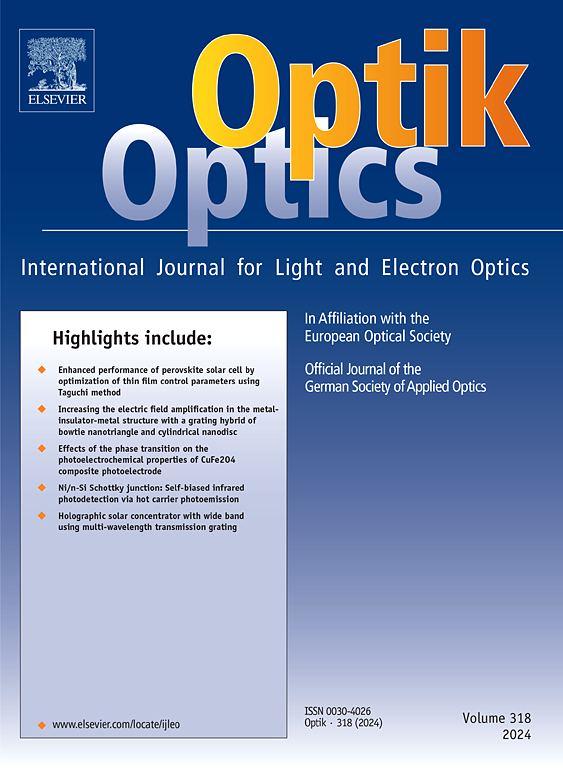用于检测生物分析物的双核镀金pcf等离子体RI传感器的设计和性能分析
IF 3.1
3区 物理与天体物理
Q2 Engineering
引用次数: 0
摘要
本文提出了一种基于表面等离子体共振(SPR)机制的传感器设计,利用金包覆双核型光子晶体光纤(DCPCF-SPR),用于在可见光到近红外(0.5-2 μm)波长范围内检测各种生物有机生化分析分子。该传感器具有两个主要的六角形环形晶格和许多圆形气孔,使得传感器结构不那么复杂,并且根据化学采用和优异的传感性能,所设计结构的外表面涂有一层深度为40 nm的金(Au)作为等离子体材料。采用有限元法对化学分析物在1.33 ~ 1.42折射率范围内的检测函数进行了研究。该传感器的最大波长灵敏度(WS)和幅值灵敏度(AS)分别为27,000 nm/RIU和1701.69 RIU - 1,分辨率分别为3.70 × 10−6 RIU和5.88 × 10−6 RIU,最大优值(FOM)为482 RIU - 1。将等离子体材料和分析物传感层放置在DCPCF的外部是设计中值得注意的,因为它表明了更容易制造工艺的可行性。根据这些结果和简单的结构设计,所建议的独特传感器可以潜在地适用于折射率(RI)检测生化溶液,生物分子物质和生物样品。本文章由计算机程序翻译,如有差异,请以英文原文为准。
Design and performance analysis of a dual-core gold-coated PCF-based plasmonic RI sensor for the detection of bio-analytes
This paper presents a straightforward sensor design based on a surface plasmon resonance (SPR) mechanism, utilizing a gold-coated dual-core type photonic crystal fiber (DCPCF-SPR) for the detection of diverse bioorganic biochemical analytical molecules in the spectral ranges of visible to near infrared (0.5–2 μm) wavelength. With two major hexagonal ring lattices and many circular air holes, the sensor construction is made to be less complicated, and the external surface of the designed structure is coated by a layer of gold (Au) that is 40 nm depth as plasmonic material depending on chemical adoption and excellent sensing performance. employing the finite element method (FEM), the detecting functions were examined for the chemical analytes in the measurement of refractive index range from 1.33 to 1.42. The maximal wavelength sensitivity (WS) and amplitude sensitivity (AS) of the proposed sensor were 27,000 nm/RIU and 1701.69 RIU−1 with the resolutions of 3.70 × 10−6 RIU and 5.88 × 10−6 RIU, respectively, and 482 RIU−1 was found as a maximum figure of merit (FOM). Placing the plasmonic material and analyte sensing layer on the DCPCF's outside is noteworthy in the design, as it indicates the feasibility of easier manufacturing processes. Following to these outcomes and a simple structural design, the suggested distinctive sensor can be potentially applicable for refractive index (RI) detecting the biochemical solutions, biomolecular substances, and biological samples.
求助全文
通过发布文献求助,成功后即可免费获取论文全文。
去求助
来源期刊

Optik
物理-光学
CiteScore
6.90
自引率
12.90%
发文量
1471
审稿时长
46 days
期刊介绍:
Optik publishes articles on all subjects related to light and electron optics and offers a survey on the state of research and technical development within the following fields:
Optics:
-Optics design, geometrical and beam optics, wave optics-
Optical and micro-optical components, diffractive optics, devices and systems-
Photoelectric and optoelectronic devices-
Optical properties of materials, nonlinear optics, wave propagation and transmission in homogeneous and inhomogeneous materials-
Information optics, image formation and processing, holographic techniques, microscopes and spectrometer techniques, and image analysis-
Optical testing and measuring techniques-
Optical communication and computing-
Physiological optics-
As well as other related topics.
 求助内容:
求助内容: 应助结果提醒方式:
应助结果提醒方式:


